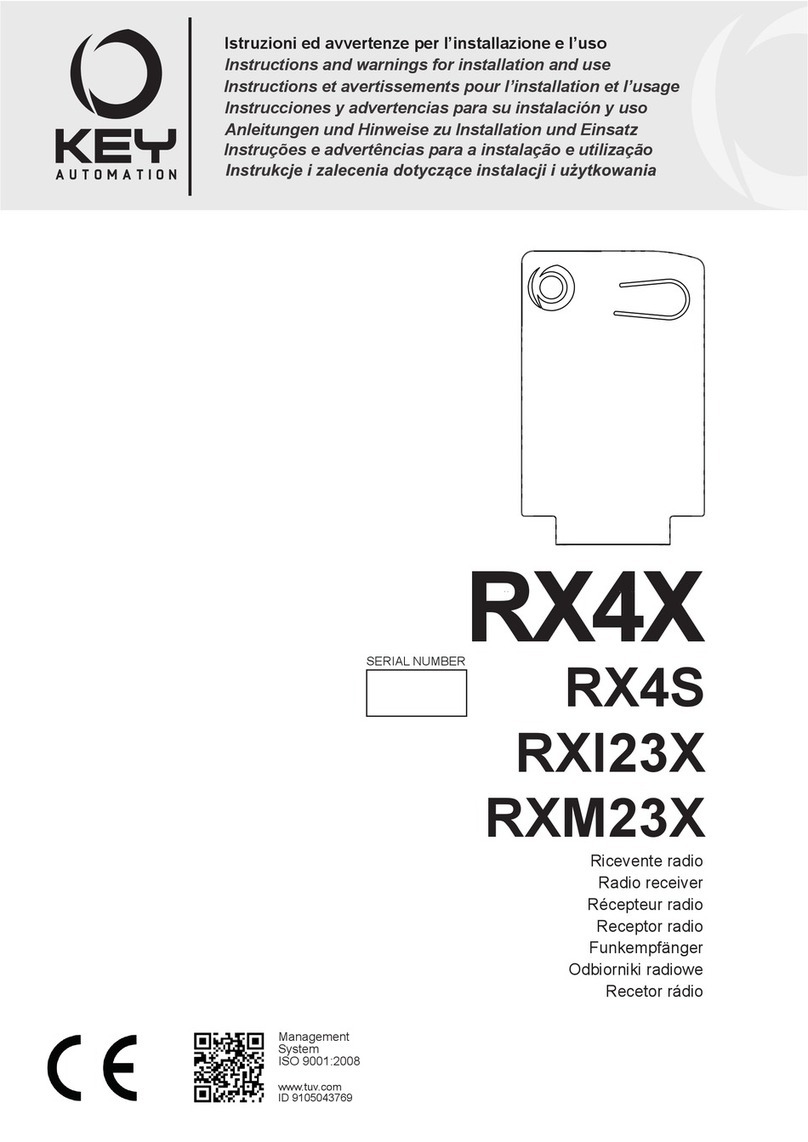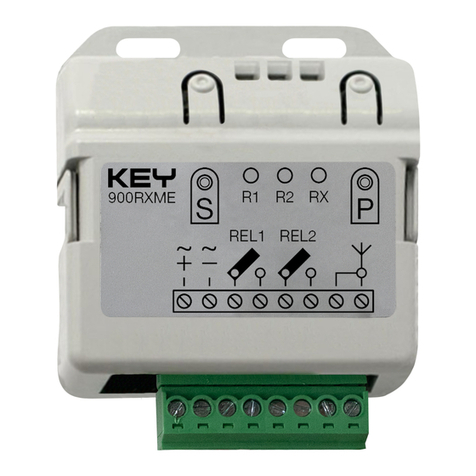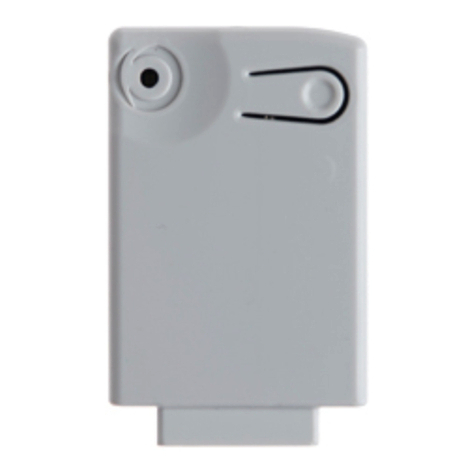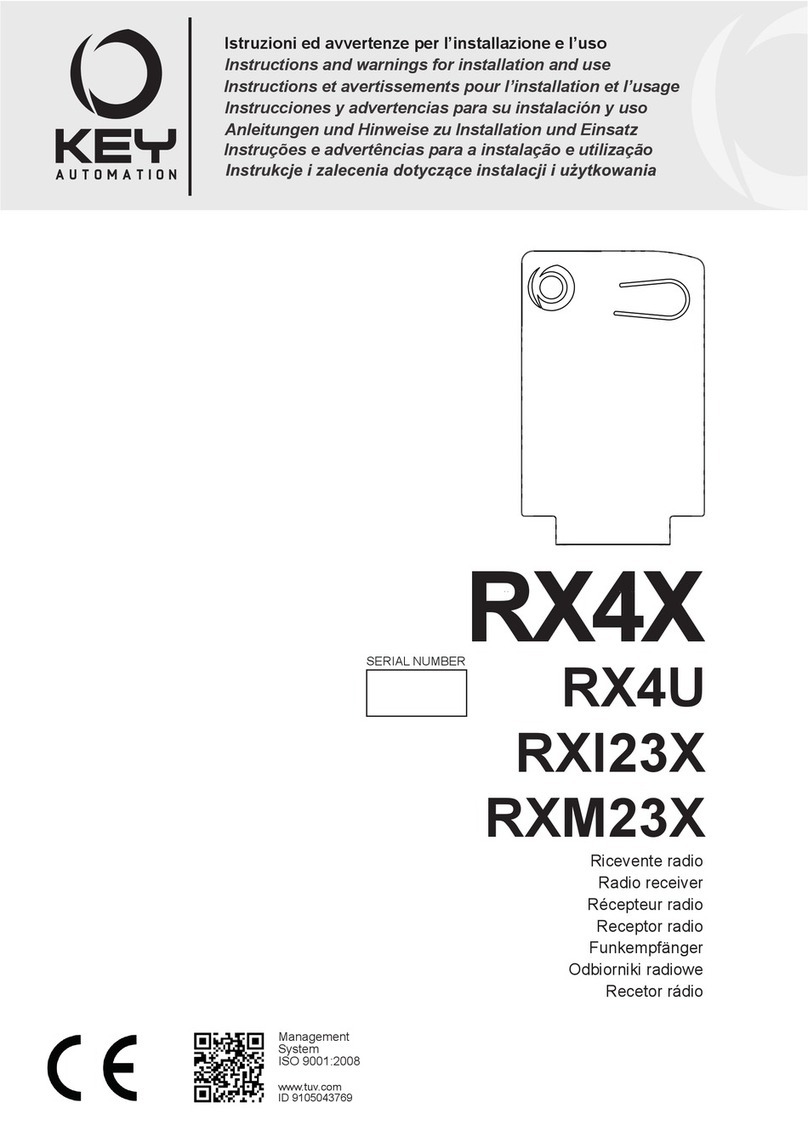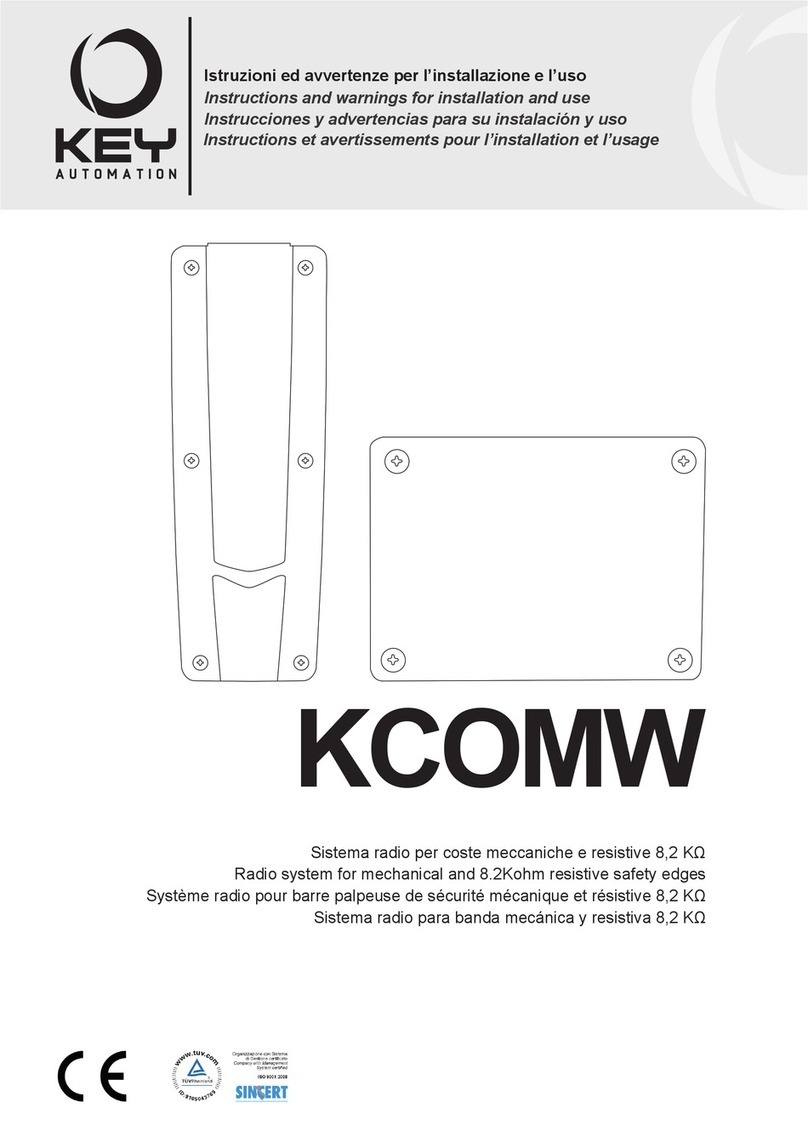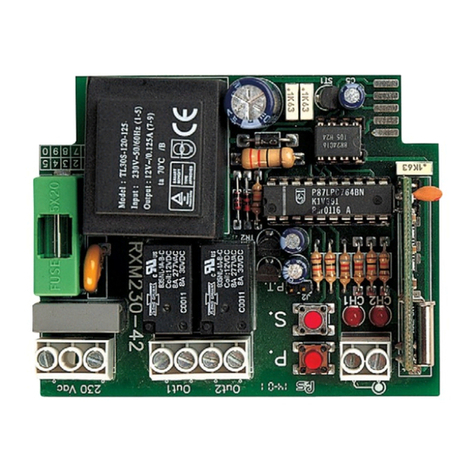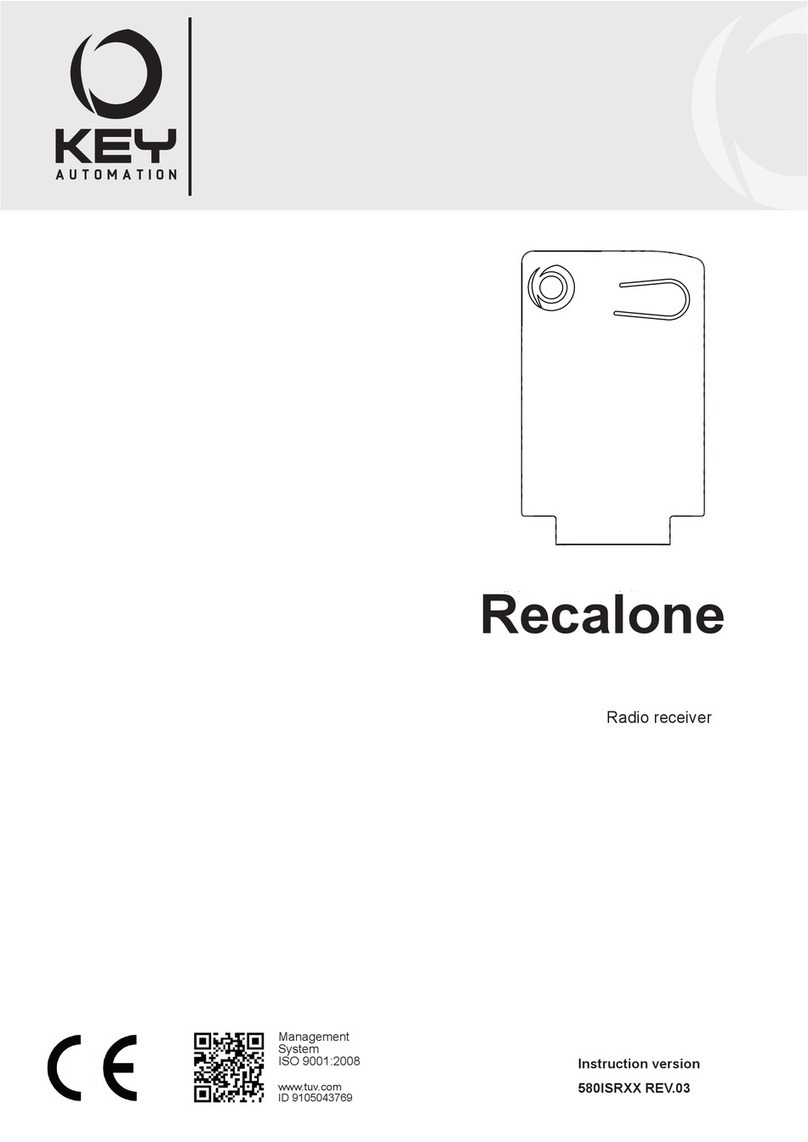
DEI
1 - SICHERHEITSHINWEISE
ACHTUNG – für die Sicherheit von Personen ist es wichtig, diese Anleitung
zu beachten und für zukünftige Nutzungen aufzubewahren.
Vor Durchführung der Installation lesen Sie die Anleitung bitte aufmerksam durch. Die Kon-
struktion und die Herstellung der Vorrichtungen, aus denen das Produkt sich zusammen-
setzt, und die in diesem Handbuch enthaltenen Informationen entsprechen den geltenden
Sicherheitsvorschriften. Dennoch können eine falsche Installation und eine falsche Program-
mierung schwerwiegende Verletzungen bei Personen verursachen, die die Arbeit ausführen
und bei denen, die die Anlage benutzen werden. Aus diesem Grund ist es wichtig, während
der Installation aufmerksam alle Anweisungen in diesem Handbuch zu beachten.
2 - EINFÜHRUNG IN DAS PRODUKT
FUNKEMPFÄNGER
Die Key Automation Funkempfänger sind Empfänger mit 4 Ausgängen für Steuerun-
gen mit Steckverbinder SSQ (RX4X/RX8), und 2 Ausgängen mit Steckverbinder Molex
(RXI23X), mit externer Klemmenleiste (RXM23X/RX28). Die Empfänger sind ausgelegt
für Sender mit feststehendem Code oder Sender mit variablem Code. Die Empfän-
ger RX4X/RMX23X/RX8/RXM28 können mit der Software und mit dem XRMANAGER
Gerät mit Firmwareversion ab 2.4 verwaltet werden (für 868MHz nur Receiver-Menü).
Achtung: Jeder andere als der in diesem Handbuch beschriebene Gebrauch und
in anderen als darin genannten Umgebungsbedingungen ist unsachgemäß und
daher untersagt.
CODE BESCHREIBUNG
RX4X Steckempfänger 4 Ausgänge, 433.92 MHz. Speicher max. 1000 Codes
RXI23X Steckempfänger Ausgänge 433.92 MHz. Speicher max. 1000 Codes
RXM23X Externer Empfänger 2 Ausgänge 433.92 MHz. Speicher max. 1000 Codes
RX8 Steckempfänger 4 Ausgänge, 868.3 MHz. Speicher max. 1000 Codes
RXM28 Externer Empfänger 2 Ausgänge 868.3 MHz. Speicher max. 1000 Codes
TECHNISCHE MERKMALE 900RX4X 900RX8 900RXI23X
900RXM23X 900RXM28
Dekodierung FIX/ROLLING
Senderkompatibilität SUB/PLAY/ORION SUB/PLAY SUB/PLAY/ORION SUB/PLAY
Frequenz 433.92 MHz 868.3 MHz 433.92 MHz 868.3 MHz
Versorgung 5 Vdc 12 ÷ 24 Vac / 12 ÷ 35 Vdc
Verbrauch im Ruhezustand 16 mA 41 mA @ 24 Vac / 20 mA @ 24 Vdc
Verbrauch max 27 mA 45 mA @ 24 Vac / 27 mA @ 24 Vdc
Eingangsimpedanz 50 Ω
Ausgänge 4 2
Relaisausgänge - 24 Vdc, 1 A MAX, NORM. OFFEN
Empndlichkeit -108 dB
Betriebstemperatur -20°+55° C
HAUPTKOMPONENTEN
RX4X/RX8 RXI23X RXM23X/RXM28
3 - VORABPRÜFUNGEN
ACHTUNG – Prüfen und kontrollieren Sie die folgenden Punkte, bevor Sie mit der
Installation beginnen:
• Prüfen, ob die Oberäche, an die das Gerät befestigt wird, stabil ist und keine
Erschütterungen ermöglicht
• Elektrische Anschlüsse verwenden, die für die geforderten Ströme geeignet sind
• Prüfen, ob die Versorgung den Werten der technischen Merkmale entspricht
• Eine Antenne vom Typ ANTS433 anschließen; ohne Antenne verringert sich die
Reichweite auf wenige Meter.
Die Antenne muss so hoch wie möglich angebracht werden, und bei Vorhandensein
von Metallkonstruktionen oder Stahlbeton muss sie oberhalb von diesen installiert
werden. Das Antennenkabel muss vom Typ RG58 sein und darf maximal 10 m lang sein.
• Ist die Installation einer Antenne nicht möglich, kann die Reichweite etwas verbessert
werden, indem ein elektrischer Draht verbunden wird und dieser gespannt bleibt.
4 - INSTALLAZIONE DEL PRODOTTO
Den Funkempfänger ohne Versorung anschließen, und für die Modelle RX4X/
RX8 die Einsteckrichtung kontrollieren, dazu die Anleitung der Steuerung befol-
gen, in die der Empfänger gesteckt wird.
Achtung: Bei einigen Steuerungen muss der Deckel von Modell RX4X/RX8
entfernt werden. Die Anleitung der entsprechenden Steuerung beachten.
Die erste eingesteckte Funksteuerung entscheidet über die Kodierungsart (fest-
stehender Code oder variabler Code) Bei Einschaltung blinkt der Empfänger
einige Male, um die Kodierung der gespeicherten Funksteuerung anzuzeigen:
• 1 x langsames Blinken = Speicher leer
• 2 x schnelles Blinken = feststehender Code
• 3 x schelles Blinken = variabler Code
4.1 SPEICHERUNG EINER FUNKSTEUERUNG
ACHTUNG: Wird die Speicherung aktiviert, kann jeder Sender im Empfangsbereich
gespeichert werden. Zur Verringerung der Reichweite des Empfängers die
4.2 LÖSCHEN EINER FUNKSTEUERUNG
4.3 LÖSCHEN DES KOMPLETTEN EMPFÄNGERSPEICHERS/
RESET DES EMPFÄNGERS
4.4 FERNSPEICHERUNG EINER FUNKSTEUERUNG MIT SCHON
GESPEICHERTER FUNKSTEUERUNG
3Innerhalb von 7 Sekunden mindestens 2 Sekunden
lang die Taste der Funksteuerung betätigen, die ge-
speichert werden soll 2s
4War die Speicherung erfolgreich, meldet der Empfän-
ger dies durch 1 langes Blinken 3s
5Für die Speicherung einer weiteren Funksteuerung auf
den selben Ausgang ist Punkt 3 zu wiederholen
Hinweis Wird innerhalb von 7 Sekunden keine Taste betätigt,
verlässt der Empfänger automatisch die Program-
mierphase
PH. BESCHREIBUNG BEISPIEL
1Die Taste des Empfängers so oft betätigen, bis die
LED aueuchtet (ca. 3 Sekunden) (>3s)->
2
Innerhalb von 7 Sekunden die Taste der Funksteuerung,
die gelöscht werden soll, so lange betätigen, bis die LED
am Empfänger erlischt. Die Taste der Funksteuerung lo-
slassen
->
3Ca. 1 Sekunde nach dem Loslassen der Taste beginnt
die LED am Empfänger zu blinken 0,5s 0,5s
4Das Löschen durch Betätigen der Taste des Empfän-
ger quittieren
5War die Speicherung erfolgreich, meldet der Empfän-
ger dies durch 1 langes Blinken 3s
Hinweis War die Speicherung erfolgreich, meldet der Empfän-
ger dies durch 1 langes Blinken
PH. BESCHREIBUNG BEISPIEL
1
Die Taste des Empfängers drücken und gedrückt hal-
ten, bis die LED (ca. 3 Sekunden) aueuchtet und
dann erlischt ( ca. 3 Sekunden). Die Taste loslassen
(>3s)-> (>3s)->
2Ca. 1 Sekunde nach dem Loslassen der Taste beginnt
die LED am Empfänger zu blinken (1s)+ (1s)+
3
Zur Löschung des gesamten Speichers beim dritten Blin-
ken auf die Empfängertaste drücken, oder zum Rücksetzen
der 4 Ausgänge und Rückstellen auf den monostabilen
Werksmodus beim fünften Blinken.
4War das Löschen/reset erfolgreich, meldet der
Empfänger dies durch 1 langes Blinken
PH. BESCHREIBUNG BEISPIEL
1Die Taste der neuen Funksteuerung, die gespeichert
werden soll, 5 Sekunden lang betätigen >5s
2
Die Taste der alten Funksteuerung, die kopiert werden
soll, 3 Sekunden lang betätigen (war die vorherige Phase
1 erfolgreich, bewegt der Antrieb sich nicht)
>3s
3Die Taste der neuen Funksteuerung, die gespeichert
werden soll, 3 Sekunden lang betätigen >3s
4
Die Taste der alten Funksteuerung, die kopiert werden
soll, 3 Sekunden lang betätigen, um die Programmie-
rung zu bestätigen und sie dann zu verlassen
>3s
Hinweis
Wird innerhalb von 7 Sekunden keine Taste betätigt,
verlässt der Empfänger automatisch die Program-
mierphase
LED
GRÜN LED
GRÜN
LED
GRÜN
TASTE TASTE TASTE
5 - PRÜFUNG UND INBETRIEBNAHME
Die Anlage kann nach erfolgter Prüfung durch einen ausgebildeten Techniker in Betrieb
genommen werden. Dieser muss die von der einschlägigen Vorschrift verlangten Tests
hinsichtlich der vorhandenen Risiken durchführen und prüfen, ob alle Vorgaben der
Vorschriften für die Anwendungen beachtet wurden.
PH. BESCHREIBUNG BEISPIEL
1
Die Taste so oft betätigen und loslassen, wie es der Num-
mer des Ausgangs entspricht, der aktiviert werden soll:
1 mal für Ausgang 1,
2 mal für Ausgang 2,
3 mal für Ausgang 3,
4 mal für Ausgang 4,
5 mal für Ausgang VOREINGESTELLT (Taste 1 =
Ausgang 1, Taste 2 = Ausgang 2, Taste 3 = Ausgang 3,
Taste 4 = Ausgang 4)
Um die vom Ausgang aktivierte Funktion zu kennen, vgl.
das Handbuch der Steuerung oder des Geräts, an das
der Empfänger installiert wird
+ +
2
Die LED am Empfänger blinkt mit der Anzahl, die dem
gewählten Ausgang entspricht, unterbrochen von einer
Pause von 1 Sekunde
+ 1s +1s
+ (~)
- (~)
12/24
Vac/Vdc
OUT 1
OUT 2
J1: = 12 Vac/Vdc
= 24Vac/Vdc
OUT1-OUT2= ausgäng monostabiler Impulsausgang
J1
Es kann ein Sender ohne Zugriff auf den Empfänger gespeichert werden. Es ist
erforderlich, über einen vorab gespeicherten Sender zu verfügen, dann wie unten
angegeben verfahren.
Die Fernkopierprozedur muss im Zuständigkeitsbereich des Empfängers durchgeführt
werden.
